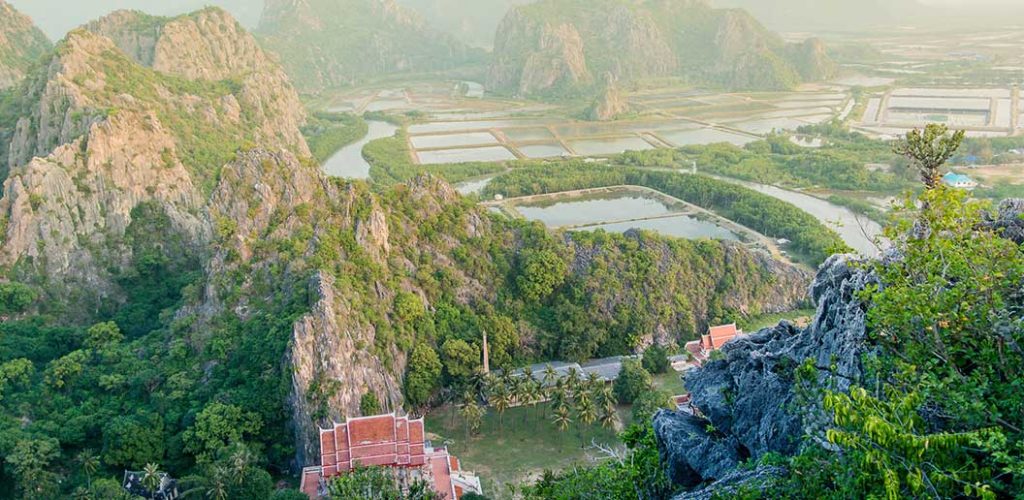Located in the Kui Buri District in the province of Prachuap Khiri Khan, Khao Sam Roi Yot National Park is Thailand’s first marine national park. This slice of paradise is filled with marshes, mangroves, mountains, farmland, beaches, islands, and tiny authentic villages on the western side of the Gulf of Thailand.
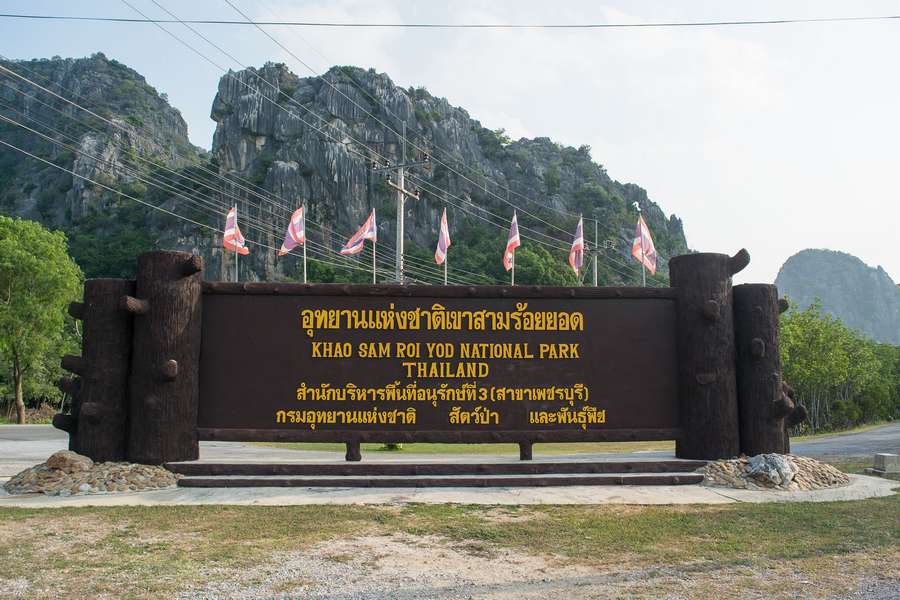 60 km south from Hua Hin and nearly three hours from Bangkok, Khao Sam Roi Yot covers about 98 square kilometers. Home to over 316 species of birds and over 50 species of mammals, the Thai government named the park as the country’s first national park in 1996. The name Khao Sam Roi Yot translates to “the mountain with 300 peaks”—dozens of jagged mountain peaks tower over your view as far as you can see. Made of limestone, they stand tall above the coastline at a height of 605 meters. These mountains are home to macaques, spectacled langur, porcupines, barking deer, dusky leaf monkeys, pangolins, and fishing cats as well as the rare Sunda pangolin and especially, the elusive mainland serow—one of the most endangered animals in the country. Also known as the goat antelope, it is one of the 15 reserved wild animal species meaning it is offered the strictest protection given to wildlife. Just west of the mountains sprawls Thung Sam Roi Yot, a majestic freshwater wetland where dozens of species of birds go fishing amid the lotuses. In addition, the mangroves hide tons of different kinds of birds, including electric blue kingfishers and purple heron as well as crabs, and giant monitor lizards. Apart from being a phenomenal contributor to the ecosystem, the mangroves also provide some welcome shade from the scorching Thai sun.
60 km south from Hua Hin and nearly three hours from Bangkok, Khao Sam Roi Yot covers about 98 square kilometers. Home to over 316 species of birds and over 50 species of mammals, the Thai government named the park as the country’s first national park in 1996. The name Khao Sam Roi Yot translates to “the mountain with 300 peaks”—dozens of jagged mountain peaks tower over your view as far as you can see. Made of limestone, they stand tall above the coastline at a height of 605 meters. These mountains are home to macaques, spectacled langur, porcupines, barking deer, dusky leaf monkeys, pangolins, and fishing cats as well as the rare Sunda pangolin and especially, the elusive mainland serow—one of the most endangered animals in the country. Also known as the goat antelope, it is one of the 15 reserved wild animal species meaning it is offered the strictest protection given to wildlife. Just west of the mountains sprawls Thung Sam Roi Yot, a majestic freshwater wetland where dozens of species of birds go fishing amid the lotuses. In addition, the mangroves hide tons of different kinds of birds, including electric blue kingfishers and purple heron as well as crabs, and giant monitor lizards. Apart from being a phenomenal contributor to the ecosystem, the mangroves also provide some welcome shade from the scorching Thai sun.
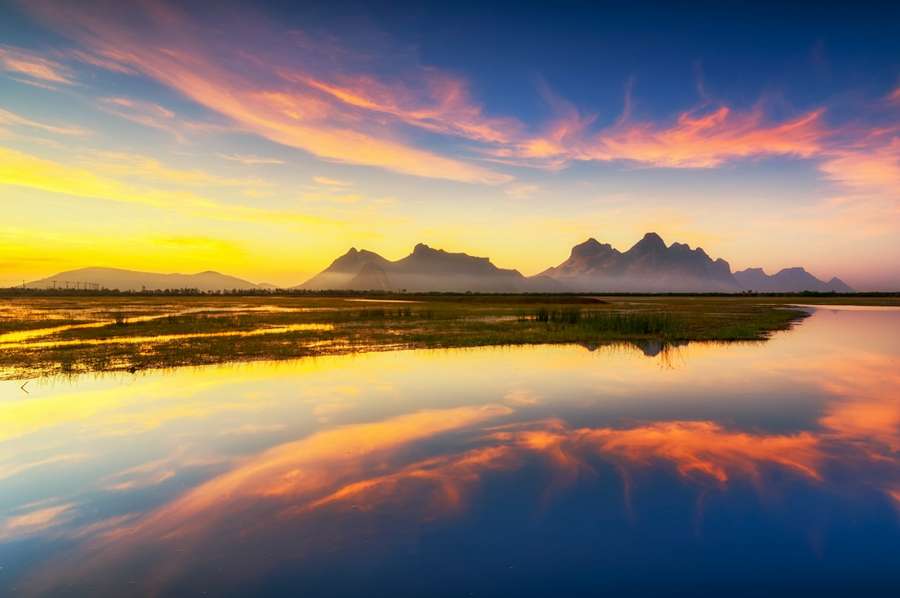 This national park and all of its attractions are open year-round and there is no bad time to visit. Weather-wise, the best time to visit Khao Sam Roi Yot is from February-May when the thermal winds come and rain is rare. Most days bring clear skies, warm weather, and not too much humidity. Rainy season runs from June-October in this part of the Gulf of Thailand so be careful but don’t cancel your plans indefinitely. The scenery after the storm clears is worth a little bit of waiting. Headquarters is located at the southern end of the park and it is within easy reach of many of the park’s attractions. There is a small museum here with some history of the area and a fairly impressive rhinoceros skeleton that was found in the area. The entrance price here is 200 Baht for foreigners and 40 Baht for Thais.
This national park and all of its attractions are open year-round and there is no bad time to visit. Weather-wise, the best time to visit Khao Sam Roi Yot is from February-May when the thermal winds come and rain is rare. Most days bring clear skies, warm weather, and not too much humidity. Rainy season runs from June-October in this part of the Gulf of Thailand so be careful but don’t cancel your plans indefinitely. The scenery after the storm clears is worth a little bit of waiting. Headquarters is located at the southern end of the park and it is within easy reach of many of the park’s attractions. There is a small museum here with some history of the area and a fairly impressive rhinoceros skeleton that was found in the area. The entrance price here is 200 Baht for foreigners and 40 Baht for Thais.
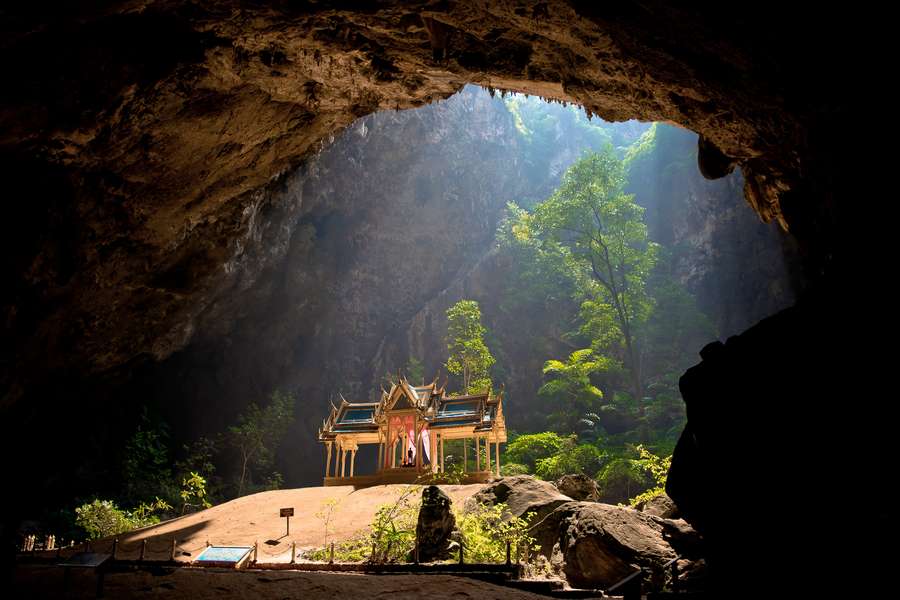 One of the most iconic symbols of the province is the Phraya Nakhon Cave and its inner pavilion. Accessible via Sam Phraya Beach or Laem Sala Beach, getting to the cave is an hour’s hike up the steep mountainside until you reach the two sinkholes, which is where the four-gable roofed royal pavilion called Phra Thinang Khuha Kharuhat stands. Built in 1890, the temple was a tribute to King Rama IV. It is believed that Khao Sam Roi Yot was probably where King Mongkut hosted European guests on 18 August 1868 to observe a total solar eclipse. The king was interested in astronomy and had calculated the date and location of the eclipse himself. His calculations proved better—by about two seconds—than those of French astronomers, who acknowledged his accuracy. Travelers sing praises of the exact moment the morning sunlight peeks through the collapsed roof and illuminates the inner cavern.
One of the most iconic symbols of the province is the Phraya Nakhon Cave and its inner pavilion. Accessible via Sam Phraya Beach or Laem Sala Beach, getting to the cave is an hour’s hike up the steep mountainside until you reach the two sinkholes, which is where the four-gable roofed royal pavilion called Phra Thinang Khuha Kharuhat stands. Built in 1890, the temple was a tribute to King Rama IV. It is believed that Khao Sam Roi Yot was probably where King Mongkut hosted European guests on 18 August 1868 to observe a total solar eclipse. The king was interested in astronomy and had calculated the date and location of the eclipse himself. His calculations proved better—by about two seconds—than those of French astronomers, who acknowledged his accuracy. Travelers sing praises of the exact moment the morning sunlight peeks through the collapsed roof and illuminates the inner cavern.
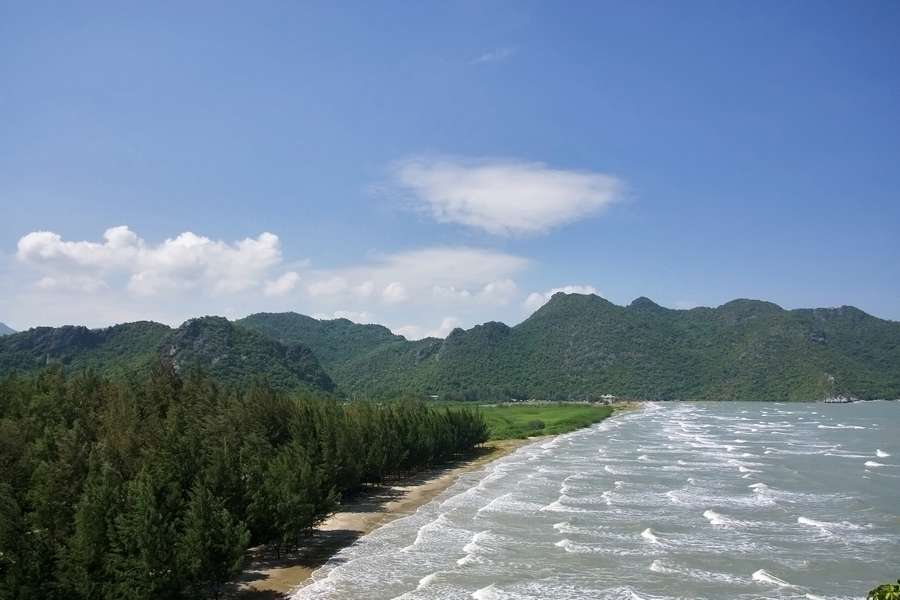 The cool water on the beach is the perfect way to refresh yourself after the hike. The beaches at Sam Roi Yot are relatively empty in comparison to the more popular beaches in the mainland. Laem Sala Beach sits at the bottom of the mountain where the Phraya Nakhon Cave is located. The beach is a stone’s throw from Bang Pu fishing village and home to a number of restaurants and souvenir shacks. Just north of the national park boundaries is where you’ll find the area’s main tourism centre at Phu Noi beach, also called Sam Roi Yot Beach. The highlight of this beach is the community of pink and grey-nosed dolphins that can often be spotted several hundred meters offshore. Further south stretches Lam Phraya beach, a small and secluded stretch of sand with a small restaurant, coffee stand and campground. Owing to a lack of outcrops, it tends to be windier. It is a fine spot for a picnic on the way down to Khao Daeng viewpoint but not really something you have to go out of the way for. Sam Phraya Beach is a nice alternative to Laem Son Beach, should you feel like mixing things up a little. Lined with pine trees, the sandy beach doubles as a campsite, with tents available to rent for just over 200 baht/night.
The cool water on the beach is the perfect way to refresh yourself after the hike. The beaches at Sam Roi Yot are relatively empty in comparison to the more popular beaches in the mainland. Laem Sala Beach sits at the bottom of the mountain where the Phraya Nakhon Cave is located. The beach is a stone’s throw from Bang Pu fishing village and home to a number of restaurants and souvenir shacks. Just north of the national park boundaries is where you’ll find the area’s main tourism centre at Phu Noi beach, also called Sam Roi Yot Beach. The highlight of this beach is the community of pink and grey-nosed dolphins that can often be spotted several hundred meters offshore. Further south stretches Lam Phraya beach, a small and secluded stretch of sand with a small restaurant, coffee stand and campground. Owing to a lack of outcrops, it tends to be windier. It is a fine spot for a picnic on the way down to Khao Daeng viewpoint but not really something you have to go out of the way for. Sam Phraya Beach is a nice alternative to Laem Son Beach, should you feel like mixing things up a little. Lined with pine trees, the sandy beach doubles as a campsite, with tents available to rent for just over 200 baht/night.
 According to Thai folklore, the giant Mong Li and his wife lived on the west coast of the Gulf of Thailand. Each had independently promised their daughter to Chao Lai and the emperor of China. When the daughter was old enough to marry, both future husbands arrived on the same date. Mong Li then cut his daughter into two halves. Chao Lai turned himself into a hill, while the traditional fruit basket to be presented to a Buddhist monk was turned into the mountains of Khao Sam Roi Yot. Other islands in the gulf were presumably shaped after the daughter’s wedding procession. The island of Ko Kho Ram on the other side of the gulf was the elephant and the ox cart with the wedding presents. Ao Sam Roi Yot, Kho Ram Island and Nom Sao Island’s silhouette, seen from certain angles, look like a person resting in the middle of the sea. Other islands in the same area include Ko Sattakut, Ko Rawang, and Ko Rawing—all of which are within paddling distance. Sam Roi Yot Beach, which faces out over Dolphin Bay, is an ideal spot for paddle boarding. The sheltered bay rarely gets anything in the way of waves, the water is crystal clear, and there are a couple of offshore islands within paddling distance. Kayaks are available to rent from many of the local businesses along the road at Sam Roi Yot Beach, and usually cost around 200-300 baht/hour (with discounts available for half day and full day rentals).
According to Thai folklore, the giant Mong Li and his wife lived on the west coast of the Gulf of Thailand. Each had independently promised their daughter to Chao Lai and the emperor of China. When the daughter was old enough to marry, both future husbands arrived on the same date. Mong Li then cut his daughter into two halves. Chao Lai turned himself into a hill, while the traditional fruit basket to be presented to a Buddhist monk was turned into the mountains of Khao Sam Roi Yot. Other islands in the gulf were presumably shaped after the daughter’s wedding procession. The island of Ko Kho Ram on the other side of the gulf was the elephant and the ox cart with the wedding presents. Ao Sam Roi Yot, Kho Ram Island and Nom Sao Island’s silhouette, seen from certain angles, look like a person resting in the middle of the sea. Other islands in the same area include Ko Sattakut, Ko Rawang, and Ko Rawing—all of which are within paddling distance. Sam Roi Yot Beach, which faces out over Dolphin Bay, is an ideal spot for paddle boarding. The sheltered bay rarely gets anything in the way of waves, the water is crystal clear, and there are a couple of offshore islands within paddling distance. Kayaks are available to rent from many of the local businesses along the road at Sam Roi Yot Beach, and usually cost around 200-300 baht/hour (with discounts available for half day and full day rentals).
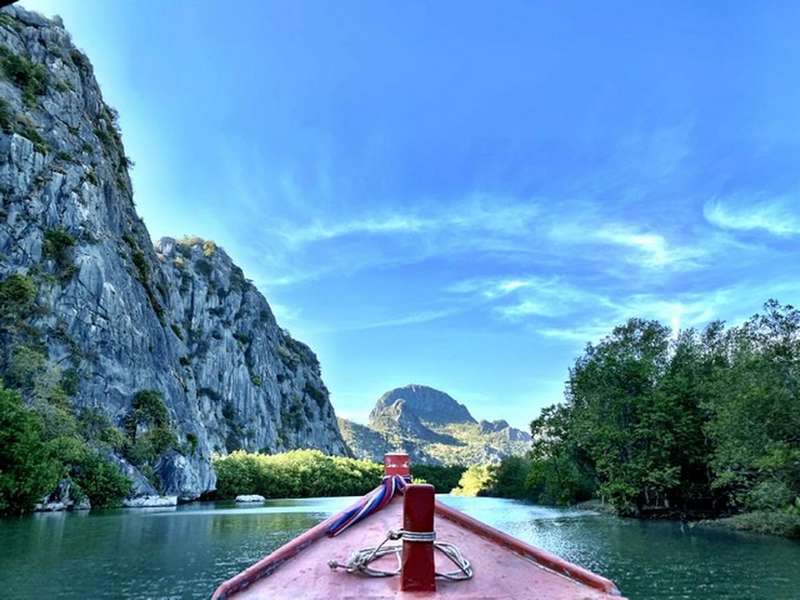 If you’d rather remain on land, the park is an epic place to go on a two-wheeled adventure, thanks to its beautiful scenery, peaceful tree-lined roads, and hidden dirt tracks through the farmlands. Apart from the mega steep mountains, the terrain around Sam Roi Yot is mostly flat with little elevation at any point. Depending on your preference and level of skill, you can pick your choice of easy going road riding and slightly more technical off-road mountain biking. But the hikes here are still steep enough that it is only recommended for those who are in good physical shape.
If you’d rather remain on land, the park is an epic place to go on a two-wheeled adventure, thanks to its beautiful scenery, peaceful tree-lined roads, and hidden dirt tracks through the farmlands. Apart from the mega steep mountains, the terrain around Sam Roi Yot is mostly flat with little elevation at any point. Depending on your preference and level of skill, you can pick your choice of easy going road riding and slightly more technical off-road mountain biking. But the hikes here are still steep enough that it is only recommended for those who are in good physical shape.
Accessed via a 250 meter long trail, the Kaeo Cave consists of several cavernous chambers and an abundance of stalactites and stalagmites. Located 16 kilometers from the headquarters towards the Bang Pu village, the cave has two entrances and it takes approximately 25 minutes to walk from one to the other. On the other hand, Sai Cave is a beautiful cave filled with impressive stalactites and stalagmites. It is accessed by a 300 meter long trail. Torches are available for rent on weekdays but the cave is lit up on weekends during peak season. The inside of the caves can actually drop in temperatures quite a bit compared to the outside temperature so make sure to wear comfortable shoes and clothing.
The hike up Khao Daeng is fast and intense; it only takes half an hour or so to reach the peak, but it’s steep and the rocky terrain is uneven in places- so best only doing this one if you’re in good physical health so it might be too much for young children or elderly. The view from the top, though, is well worth it. At just shy of 160 meters altitude, the Khao Daeng viewpoint provides a 360 degree view over the sea, mountain,
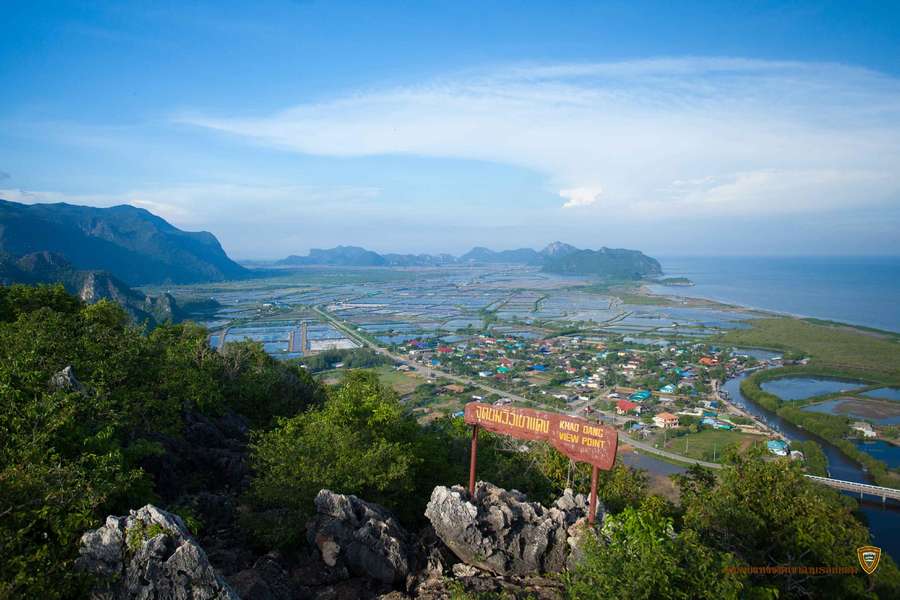 Forest and shrimp farms below – best viewed at sunrise. Like some of the other tourist attractions in Khao Sam Roi Yot National Park, the Khao Daeng hike is only open for visitors between 8 AM till 3.30 PM and if you have a dog, you’re not allowed to bring them on the hike with you. Down at the canal of the same name is filled with stunning scenery and mangroves. You can easily hop on a boat tour of the Khao Daeng Canal from the Ban Khao Daeng Village. These boat trips last approximately one hour and the perfect time to truly appreciate the scenery of the area is sunset. From limestone hilltop to deep valleys filled with chirping birds and macaques, Khao Sam Roi Yot National Park remains one of Hua Hin’s most tranquil natural attractions.
Forest and shrimp farms below – best viewed at sunrise. Like some of the other tourist attractions in Khao Sam Roi Yot National Park, the Khao Daeng hike is only open for visitors between 8 AM till 3.30 PM and if you have a dog, you’re not allowed to bring them on the hike with you. Down at the canal of the same name is filled with stunning scenery and mangroves. You can easily hop on a boat tour of the Khao Daeng Canal from the Ban Khao Daeng Village. These boat trips last approximately one hour and the perfect time to truly appreciate the scenery of the area is sunset. From limestone hilltop to deep valleys filled with chirping birds and macaques, Khao Sam Roi Yot National Park remains one of Hua Hin’s most tranquil natural attractions.


